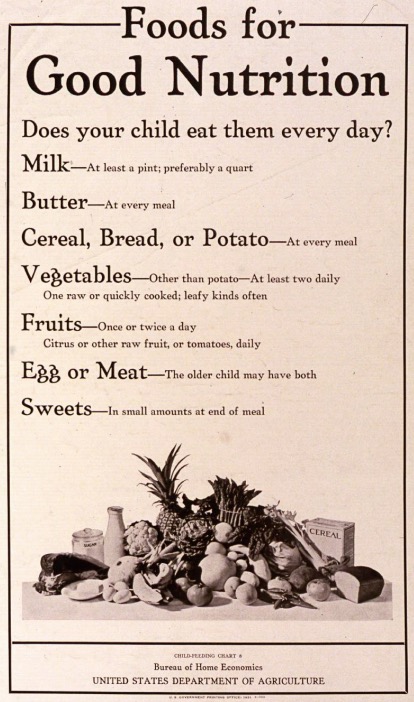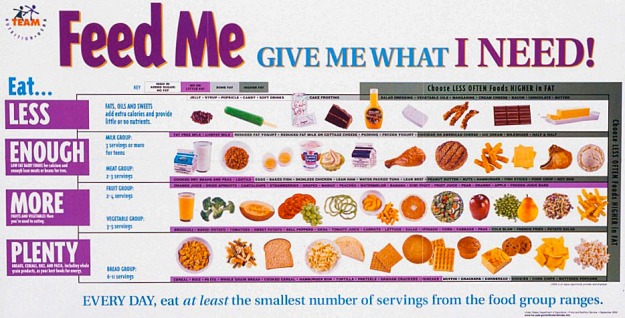
This poster was created in 1919. The government thought this constituted a healthy meal. A lot has changed about our dietary needs. We have had years of carb loading as an official government policy. The USDA has again changed its guidelines. The food pyramid asking us to eat six to eleven servings a day of bread, cereal, rice and pasta has been replaced. Since 2011, we have a simpler graphic of a plate divided into sections for vegetables, fruit, protein and grains. You can have a little dairy on the side.

What have been the past recommendations by the government for nutrition? What other posters have been issued? Do you think we are now making the best recommendations?
The U.S. government early on recommended few fruits and vegetables. The focus was on having enough protein. Workers needed protein for energy to do a hard day’s work. Vitamins were discovered in the early 1900’s. Then, fruits and vegetables started getting better billing. Healthy meals still revolved around milk. The nation’s top nutrition experts advised drinking whole milk over skim for kids. They also advised buttering their bread. Use plenty of butter. The government also recommended a dinner consisting of milk toast, stewed peaches, and a cupcake.
The government started publishing some nutrition guidelines for children in this 1939 poster and some pamphlets in the early 1930s. People were more aware about getting the vitamins they needed. The USDA recommended cereal that was vitamin-enriched. Lots of butter was still suggested. Specific recommended dietary allowances (RDAs) were introduced around 1941.

The USDA decided to reduce the 12 major food groups it had recognized since 1933 down to 7. They were called “The Basic 7.” The agency printed this poster the following year in 1943 to illustrate the new system. Butter and fortified margarine were their own category. Both contain vitamin A. Recommended daily allowances were not included for the groups until 1946. Experts advised eating from all the groups. This 1943 poster is probably familiar to many readers.

By the 1990s, the government realized that our diets were too high in fat. It was recognized as a cause of heart disease. As a result, the USDA created the food pyramid. The pyramid advised sparing consumption of fats. Instead, it told us to eat plenty of bread, cereal, pasta, and rice. This poster was published around 1992.
 The next nutrition poster iteration appeared as this in 2000. The Team Nutrition campaign advised plenty of food from the bread group. Kids were encouraged to eat more grain, fruit, and vegetables. Less fat was encouraged. Some odd suggestions were in it. Eat more vegetables such as potato salad and french fries. Have some pudding for dairy. Click to embiggen.
The next nutrition poster iteration appeared as this in 2000. The Team Nutrition campaign advised plenty of food from the bread group. Kids were encouraged to eat more grain, fruit, and vegetables. Less fat was encouraged. Some odd suggestions were in it. Eat more vegetables such as potato salad and french fries. Have some pudding for dairy. Click to embiggen.
To much fanfare on June 2, 2011, First Lady Michelle Obama and USDA Secretary Tom Vilsack unveiled the latest version of recommendations known as the MyPlate campaign.
MyPlate illustrates the five food groups that are the building blocks for a healthy diet using a familiar image—a place setting for a meal. Before you eat, think about what goes on your plate or in your cup or bowl.
Choose from the following: Fruits, Vegetables, Grains, Protein Foods, and Dairy. Within the link, each group is illustrated with links to examples of the various choices.
What do you think? Have we made the right kind of progress with nutritional information campaigns over the years? Are there approaches you feel would be better? Do you have first-hand experience and insight you can offer?


Reblogged this on Our View From Iowa.
One “advantage” in getting to be of a certain age is that the cyclical nature of trends becomes apparent. If we live long enough, the recommendations on the posters from 1919 and 1941 will probably be back in vogue. So will bell-bottom pants, alas.
Probably so. But, I will refuse to buy bell-bottom pants again. Trip hazard for old guys.
I refused the first time around.
Leisure suits? Do you still have one?
Nope, never did. You can tell that fashion and I are strangers.
Interesting post! I googled what other countries have done, and found pyramids, rainbows, staircases, and even apples. They are all similar, although I looked at the oriental ones a little closer since their longevity is higher than westerner’s folks. It’s a slide show I found here:
(http://magazine.good.is/slideshows/pyramids-plates-and-pagodas-dietary-guidelines-from-around-the-world#0)
That was an interesting and informative slide show. Some gave me a chuckle. I hope others take a look at it.
Thank you for including it today.
Oh, boy, do I ever. My children were born under the food pyramid that recommended lots of grain, so I did my best. Whole-wheat bread, rice, etc. I began to notice weight coming on no matter how hard I exercised, a loss of energy, strange rashes, and finally severe pain in all of my joints. Obviously something was wrong, but I didn’t know what because I was following the USDA recommendations. THen I came across the “Wheat Belly Book”. It opened my eyes to what is going on in our country. We aren’t meant to eat all that grain, and it is killing us! One week with no grain and the rashes disappeared, the pain in my joints disappeared, and weight came off. I feel better than I have in years. Here’s to Michele Obama for starting me in the right direction.
I imagine there are many different degrees of reaction to grains. It seems good advice to have most things in moderation. Of course, if you discover something that is especially bad for you, skip it. It sounds like you were able to do that and with good success.
Keep feeling well.
Thanks, Jim. Usually I can get by with an occasional slice of pizza or half bagel when I’m craving it. I’ve learned a lot about nutrition from this. Thank you for the post.
It makes sense that our increasing knowledge will modify the food recommendations. Unfortunately, those who stand to profit will have a lot, maybe-no probably, to say about those recommendations if current political trends continue.
On the other hand, I would be quite happy to see cupcakes in the pyramid.j
I think one of the important roles of government agencies is to help we cupcake eaters make good choices. There should be a chocolate layer to the pyramid. Doesn’t it have anti-oxidents or something like that?
Especially when combined with red wine.
This has nothing to do with red wine.
I came across this web site today showing the highest points in each county of the states. http://peakbagger.com/list.aspx?lid=13316
You might already know about this.
Though I’m not familiar with the poster from 1943, I gotta love the bit on the bottom, “In addition to the Basic 7…eat any other foods you want”!
Personally, I have to reject any nutritional guidelines that don’t include coffee. 😉
True. How many cups a day for you ?
Most of the advice given over the past century would appear to be bad advice. It would probably have been much better if the government had never given any advice at all.
Still doctors cannot answer basic questions, such as whether butter or margarine is better. Still there are arguments over fat. It’s not surprising there so many food fads in the popular press.
Food fads sell because they seem to have some truth in them, and they seem “easy.” If I can just eat “paleo” enough I’ll be super healthy! Or whatever… I see a lot of comments on posts, from people who are dogmatic in their food beliefs. I think the most sensible advice is from Michael Pollan: “Eat food. Not too much. Mostly plants.”
That seems like a pretty succinct statement of the current best practice.
I’ve taken to Dr. Mark Hyman’s “functional medicine” way of eating. He says all the medicine most people need is on the tip of their fork. Eliminate anything that comes in a package. No counting calories. Double up on the veggies. Anti-oxidant fruit smoothies and green tea for breakfast. Pounds drop off. You have more energy. You have less “brain fog”. You are not hungry for sweets. Forget the Government Nutrition posters. Forget Weight Watchers. Get in some exercise and meditation. Help your body detox with a hot bath of Epsom salts, baking soda and lavender oil before bed and sleep like a baby.
I recommended Dr. Hyman’s diet to my cousin. In a few months her doctor took her off of her meds for cholesterol. A while later her high blood pressure pills were a thing of the past.
Sounds like that is working very well for you and your cousin. Lots of good advice there. We’ve eliminated packaged foods, eat lots of veggies, put berries on and in a lot of cereal and homemade yogurt, etc. Another key is the exercise and mindfulness part.
Thank you for sharing those good words of advice. Keep it up.